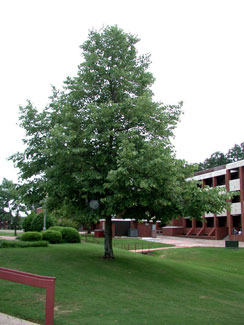Resource Library
Plant of the Week: Linden, American
The University of Arkansas System Division of Agriculture does not promote, support or recommend plants featured in "Plant of the Week." Please consult your local Extension office for plants suitable for your region.
Plant of the Week
American Linden
Latin: Tilia americana

Every morning when I make my coffee I think of my late friend Ken Scott. Ken, a friend and co-worker, was known throughout Arkansas in his role as Extension horticulturist, but also because of his whimsical, hillbilly style carvings.
His gift to me was a set of hand-carved scoops, the smallest of which is just the right size for measuring ground coffee. The scoop is made of Ken’s favorite wood for carving, American basswood, or Tilia americana.
The American linden is a big tree growing to over 80 feet tall with stout, straight gray-black, deeply furrowed boles. Traditionally lindens have been placed in their own family, but DNA research now combines them with malvaceous plants like cotton and okra.
In their youth trees, are pyramidal in outline but with age they become more round-topped. They have a tremendous leaf load and cast a very deep shade. The species ranges throughout the eastern deciduous forest from southern Canada to the northern reaches of the gulf coast states where it typically is found in mixed forests along rivers and streams in rich, deep fertile bottomland.
It produces heart shaped leaves to 6 inches long with a lustrous dark green upper surface and a lighter, sometimes white-wooly undersurface that flashes in the breeze. Fall color is a yellow but not usually spectacular.
The linden flowers are pale yellow and appear in late spring after the leaves have emerged and are seldom noticed except for their sweet fragrance. Where basswood is found in large numbers in the forest it is a favorite of bees and makes an excellent and distinctive honey.
Though the flowers make little visual impression the distinctive seed structure – a cluster of pea sized berries on a branched peduncle attached to a finger shaped leafy bract – are distinctive and unique amongst plants. The role of the bract is to serve as a rotor blade to disperse the seeds just outside the canopy of the parent tree.
About 30 species of Tilia are described, with most found in Europe and Asia where they typically are known as lindens or limes. In America. they are known as lindens or basswood. In North America, the current taxonomic thinking is that there is only one species, T. americana with two major varieties. In the northern part of the range T. americana var. americana grows. In this variety the lower leaf surface is glabrous and pale green. In the southern part of the range, including Arkansas, T. americana var. heterophylla is found which differs in that the lower leaf surface is white pubescent. This southern variety is sometimes called white basswood.
Linden wood is lightweight and free of grain, making it ideal for boxes, carving and use in musical instruments such as the base for electric guitars. It is called basswood in North America because the Native Americans used it to make a strong fiber called bast. The inner bark, the phloem, was stripped from the trees and soaked in water for a month to produce a strong and flexible fiber that was primarily used to make rope and cordage. Basswood was the tree from which the bast fiber was made.
Basswood, while a beautiful tree in its own right, is overly large for most home landscapes and its preference for deep bottomland sites makes it a poor choice for most situations except parks, golf courses and similar large sites. It is only infrequently encountered in the nursery trade.
By: Gerald Klingaman, retired
Retired Extension Horticulturist - Ornamentals
Extension News - February 15, 2013
The University of Arkansas System Division of Agriculture does not maintain lists of retail outlets where these plants can be purchased. Please check your local nursery or other retail outlets to ask about the availability of these plants for your growing area.